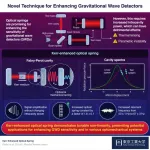(Press-News.org) (SAN ANTONIO, TEXAS) — UTSA has signed a memorandum of understanding (MOU) with the U.S. Department of Energy Advanced Research Projects Agency – Energy (ARPA-E), the City of San Antonio, and CPS Energy to develop and promote energy technologies that could potentially decarbonize the aviation sector. The ambitious project will pursue a range of research and development objectives, including sustainable aviation technologies, battery technologies and battery storage solutions, enhanced electric vehicle charging technologies and power-related technologies. The MOU will position San Antonio as an innovation center for these new energy solutions, accelerating their development and deployment across the country.
Wednesday’s agreement marks the first time an international airport will work with ARPA-E, the DOE’s innovation arm, to decarbonize the aviation sector. SAAS is home to the San Antonio International Airport and Stinson Municipal Airport.
UTSA was invited to join the partnership due to its commitment to growing the state’s leading industries, including aerospace and the new energy economy, and its ability to serve as the region’s top producer of workforce talent in these fields. As the partners begin their work, UTSA faculty, staff and students will further advance projects in energy research and innovation, including the integration of renewables, energy-storage solutions and the fortification of the cybersecurity framework as the power grid is modernized.
“This collaborative effort is an incredible opportunity for UTSA to partner with strategic industry leaders in evaluating electric aircraft, advanced energy storage and micro-grid systems to advance the adoption of sustainable multi-modal transportation technologies,” said UTSA President Taylor Eighmy. “Together, this collective will accelerate discoveries that will positively impact the local and regional economies while advancing technologies that change the world.”
Central to UTSA’s work in renewable energy initiatives is the Texas Sustainable Energy Research Institute (TSERI), which elevates UTSA’s position, and that of San Antonio, as a significant contributor to the global energy economy. The institute integrates scientific discovery, engineering innovation and policy deliberations with pragmatic implementation. TSERI, a center of intellectual creativity, provides technology systems solutions to reduce costs, improve reliability and assure responsible environmental stewardship.
This partnership marks the latest example of the strategic alliances UTSA is forging with leaders in the private, nonprofit and governmental sectors, a network that is providing UTSA’s students with the experiential learning opportunities they need to put their classroom learning to work before graduation and gain a competitive edge in the job market.
“We are committed to facilitating research that solves the grand challenges of our time, and few challenges are as formidable as the pressing need for energy security and sustainability,” said JoAnn Browning, UTSA interim vice president for research. “This collaboration is an opportunity for UTSA to continue to uphold that commitment and pursue discoveries that shape our world in positive ways.”
In 2010, TSERI forged a strategic alliance with CPS Energy to develop advanced research projects in grid modernization. This alliance set the stage for several projects developed collaboratively by UTSA and CPS Energy, including energy management systems for the integration of battery storage systems and solar panels in building applications.
In recent years, a team of researchers at TSERI has achieved notable milestones, including creating a digital twin of San Antonio that makes it possible for decision makers to map out the city’s intricate grid infrastructure and better understand the impact of electric vehicles charging station demands on grid operations. The system is adaptable, making it possible to understand the impact that the burgeoning e-aircraft technology could have on the grid, ensuring both grid stability and efficiency.
“UTSA remains deeply invested in leveraging digital twin and microgrid testbeds as instrumental platforms for evaluating operational efficacy, ensuring seamless interoperability, fortifying cybersecurity protocols, and meticulously assessing performance metrics vis-à-vis design standards,” said Krystel Castillo, Lutcher Brown Chair in Mechanical Engineering in the Margie and Bill Klesse College of Engineering and Integrated Design and director of TSERI. “This holistic approach includes a spectrum of technologies, encompassing e-aircraft, batteries and charging infrastructure, thereby fostering innovation and resilience within the energy and decarbonization landscape.”
Eighmy joined ARPA-E Director Evelyn Wang, San Antonio Mayor Ron Nirenberg and CPS Energy Chief Customer Strategy Officer DeAnna Hardwick at Wednesday's event.
The event was also an opportunity for the ARPA-E-funded teams working on this project to demonstrate their latest innovations, including a hybrid-electric aircraft, a new system of ultrafast, compact electric-vehicle chargers, sodium-ion batteries, and a new energy-resource-management system.
During the event, Castillo shared ongoing research underway at TSERI, including a city-scale grid digital twin. This digital replica of the city's infrastructure enables predictive analysis and optimization of power demand as the multi-modal transportation sector transitions to electrified vehicles.
Earlier this year, UTSA announced a pioneering initiative to reshape its academic landscape by creating a new college dedicated to artificial intelligence (AI), cybersecurity, computing, data science and related disciplines. This initiative positions UTSA and its students to lead in the rapidly evolving landscape of advanced technologies, and to fill the in-demand jobs in the industry.
END
UTSA joins consortium to create sustainable aviation hub in San Antonio
In partnership, UTSA will help develop and promote energy technologies to potentially decarbonize the aviation sector
2024-04-05
ELSE PRESS RELEASES FROM THIS DATE:
Kerr-enhanced optical spring for next-generation gravitational wave detectors
2024-04-05
The detection of gravitational waves stands as one of the most significant achievements in modern physics. In 2017, gravitational waves from the merger of a binary neutron star were detected for the first time which uncovered crucial information about our universe, from the origin of short gamma-ray bursts to the formation of heavy elements. However, detecting gravitational waves emerging from post-merger remnants has remained elusive due to their frequency range lying outside the range of modern gravitational wave detectors (GWDs). ...
Magnetic resonance imaging in prostate cancer screening
2024-04-05
About The Study: The results of this systematic review and meta-analysis suggest that integrating magnetic resonance imaging (MRI) in prostate cancer screening pathways is associated with a reduced number of unnecessary biopsies and overdiagnosis of insignificant prostate cancer while maintaining clinically significant prostate cancer detection as compared with prostate-specific antigen (PSA)-only screening.
Authors: Shahrokh F. Shariat, M.D., D.Dr.(hc), of Medical University Vienna in Vienna, is the corresponding author.
To access the embargoed study: Visit our For The Media website at this link https://media.jamanetwork.com/
(doi:10.1001/jamaoncol.2024.0734)
Editor’s ...
The sense of smell is influenced by cues from other senses
2024-04-05
The sense of smell is highly influenced by the cues from other senses, while the sense of sight and hearing are affected to a much lesser extent, shows a new study in Journal of Neuroscience.
A popular theory of the brain holds that its main function is to predict what will happen next, so it reacts mostly to unexpected events. Most research on this topic, called predictive coding, has only focused on what we see, but no one knows if the different senses, such as smell, work in the same way.
To figure out more about how smell relates to how we ...
RNA that doesn’t age
2024-04-05
Certain RNA molecules in the nerve cells in the brain last a life time without being renewed. Neuroscientists from Friedrich-Alexander-Universität Erlangen-Nürnberg (FAU) have now demonstrated that this is the case together with researchers from Germany, Austria and the USA. RNAs are generally short-lived molecules that are constantly reconstructed to adjust to environmental conditions. With their findings that have now been published in the journal Science, the research group hopes to decipher the complex aging process of the brain and gain a better understanding of related degenerative diseases.
Most cells in the human ...
Study finds many younger people from high income neighborhoods jumped the eligibility queue for COVID-19 vaccines in NYC
2024-04-05
Despite vaccine shortages, many younger people in New York City accessed vaccines ahead of schedule, particularly in high-income areas, according to new research at Columbia University Mailman School of Public Health. Low-income areas with high proportions of older people demonstrated lower coverage rates than wealthier areas in the first three months of vaccine rollout, and higher mortality over the year. The findings are published in the Journal of Urban Health.
“A vaccine program that prioritized those at greatest risk of COVID-19-associated morbidity and mortality would have prevented more deaths than the strategy that was implemented,” said Nina Schwalbe, adjunct ...
Rapid, simultaneous detection of multiple bacteria achieved with handheld sensor
2024-04-05
Hear the words E. coli or salmonella and food poisoning comes to mind. Rapid detection of such bacteria is crucial in preventing outbreaks of foodborne illness. While the usual practice is to take food samples to a laboratory to see the type and quantity of bacteria that forms in a petri dish over a span of days, an Osaka Metropolitan University research team has created a handheld device for quick on-site detection.
Led by Professor Hiroshi Shiigi of the Graduate School of Engineering, the team experimented with a biosensor that can simultaneously detect multiple disease-causing bacterial species within an hour.
“The palm-sized device for detection ...
Suicides among US college student athletes have doubled over past 20 years
2024-04-05
The number of suicides among US college student athletes has doubled over the past 20 years, finds an analysis of data from the National Collegiate Athletic Association (NCAA), published online in the British Journal of Sports Medicine.
Suicide is now the second most common cause of death after accidents in this group of young people, with rates highest among cross-country competitors, the findings show.
US suicide rates rose by around 36% across all age groups between 2001 and 2021, note the researchers. But the evidence ...
The Lancet: Prostate cancer cases expected to double worldwide between 2020 and 2040, new analysis suggests
2024-04-05
The Lancet: Prostate cancer cases expected to double worldwide between 2020 and 2040, new analysis suggests
Annual prostate cancer cases are projected to rise from 1.4 million in 2020 to 2.9 million in 2040, and annual deaths to increase by 85% to almost 700,000 over the same timeframe, mainly among men in low-and middle-income countries (LMICs).
The Lancet Commission on prostate cancer argues that the ‘informed choice’ programme for prostate cancer screening with PSA testing, which is common in high-income countries ...
Britain began industrializing in the 17th century – over a 100 years earlier than history books claim
2024-04-05
Britain was already well on its way to an industrialised economy under the reign of the Stuarts in the 17th century – over 100 years before textbooks mark the start of the Industrial Revolution – according to the most detailed occupational history of a nation ever constructed.
Built from more than 160 million records and spanning over three centuries, the University of Cambridge’s Economies Past website uses census data, parish registers, probate records and more to track changes to the British labour force from the Elizabethan era to the eve of World War One.
The research shows that 17th century Britain saw a steep decline ...
Bladder cancer treatment can be better targeted and more effective, trials show
2024-04-05
Testing for tumour DNA in the blood can successfully identify advanced bladder cancer patients who will not relapse following surgery, new research shows.
This could allow doctors to target treatments more effectively to those who need it, and spare those patients for whom further treatment is unnecessary, researchers say.
The findings from the screening phase of the IMvigor011 Phase III trial are presented today [Friday 5 April] at the European Association of Urology Congress in Paris.
They show that just over 90% of muscle invasive bladder cancer (MIBC) patients with a ...
LAST 30 PRESS RELEASES:
Neuroscientists devise formulas to measure multilingualism
New prostate cancer trial seeks to reduce toxicity without sacrificing efficacy
Geometry shapes life
A CRISPR screen reveals many previously unrecognized genes required for brain development and a new neurodevelopmental disorder
Hot flush treatment has anti-breast cancer activity, study finds
Securing AI systems against growing cybersecurity threats
Longest observation of an active solar region
Why nail-biting, procrastination and other self-sabotaging behaviors are rooted in survival instincts
Regional variations in mechanical properties of porcine leptomeninges
Artificial empathy in therapy and healthcare: advancements in interpersonal interaction technologies
Why some brains switch gears more efficiently than others
UVA’s Jundong Li wins ICDM’S 2025 Tao Li Award for data mining, machine learning
UVA’s low-power, high-performance computer power player Mircea Stan earns National Academy of Inventors fellowship
Not playing by the rules: USU researcher explores filamentous algae dynamics in rivers
Do our body clocks influence our risk of dementia?
Anthropologists offer new evidence of bipedalism in long-debated fossil discovery
Safer receipt paper from wood
Dosage-sensitive genes suggest no whole-genome duplications in ancestral angiosperm
First ancient human herpesvirus genomes document their deep history with humans
Why Some Bacteria Survive Antibiotics and How to Stop Them - New study reveals that bacteria can survive antibiotic treatment through two fundamentally different “shutdown modes”
UCLA study links scar healing to dangerous placenta condition
CHANGE-seq-BE finds off-target changes in the genome from base editors
The Journal of Nuclear Medicine Ahead-of-Print Tip Sheet: January 2, 2026
Delayed or absent first dose of measles, mumps, and rubella vaccination
Trends in US preterm birth rates by household income and race and ethnicity
Study identifies potential biomarker linked to progression and brain inflammation in multiple sclerosis
Many mothers in Norway do not show up for postnatal check-ups
Researchers want to find out why quick clay is so unstable
Superradiant spins show teamwork at the quantum scale
Cleveland Clinic Research links tumor bacteria to immunotherapy resistance in head and neck cancer
[Press-News.org] UTSA joins consortium to create sustainable aviation hub in San AntonioIn partnership, UTSA will help develop and promote energy technologies to potentially decarbonize the aviation sector




